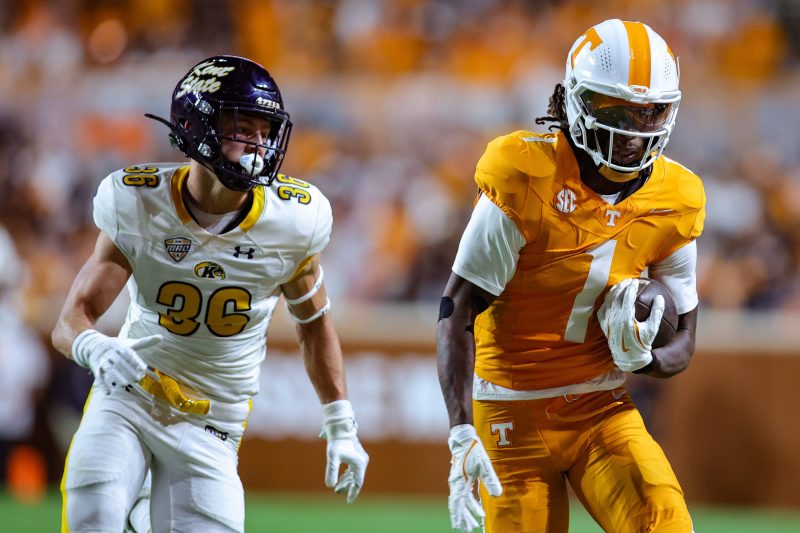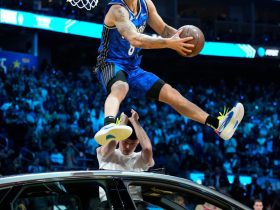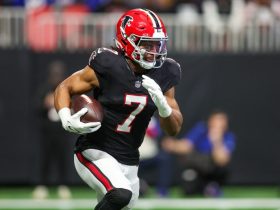What exactly constitutes an NFL draft sleeper in 2025?
Satisfying the label is exceedingly difficult. Prospects who once received minimal media attention now are thoroughly examined in the pre-draft process, leaving few to truly fly under the radar. And the depth of the individual classes has also shifted radically in recent years amid a new era of Name, Image and Likeness rules, with this year’s 70 early declarations representing just more than half of the total from 2021.
But without fail, the draft has continued to produce players who quickly defy their draft stock by making massive early contributions, with fourth-round Tampa Bay Buccaneers running back Bucky Irving and Los Angeles Chargers cornerback Tarheeb Still emerging as the latest Day 3 picks to make an instant mark.
With the draft about a week away, here’s our look at 14 potential sleepers in this year’s class:
RB Jacory Croskey-Merritt, Arizona
Having played in just one game last season due to eligibility issues and then being snubbed for the NFL Scouting Combine, Croskey-Merritt has been somewhat overlooked in the last six months. But the Alcorn State and New Mexico transfer showed off as one of the biggest standouts at the East-West Shrine Bowl, and his stellar Big 12 Pro Day numbers – a 4.45-second 40-yard dash and 41 1/2-inch vertical leap – underscored his explosiveness. The 5-10, 206-pound slasher can change direction in an instant, and his combination of elusiveness and strength make him exceedingly difficult to bring down at the second level. There’s a missing element of reliability to his game, with a sense of chaos to his pass protection, ball security and running style. But his knack for operating in tight quarters should translate well to the NFL.
RB Jaydon Blue, Texas
Unearthing gems in the middle to later portions of the draft is often a matter of finding players with a superpower. Blue has one: his speed. The 5-9, 196-pound ball carrier can outrace an entire defense once he gets to the perimeter, and his confident cuts can punish anyone who overcommits. Blue’s effectiveness wanes when he’s forced to work inside, but his big-play ability as both as a runner and receiver could make him an optimal third-down and change-of-pace back.
WR Dont’e Thornton Jr., Tennessee
It’s easy to understand the appeal of a 6-5, 205-pound target who led the Football Bowl Subdivision with 25.4 yards per catch last season. Tennessee’s scheme undoubtedly juiced some of his numbers, but Thornton dusted some of college football’s best defenses when defensive backs didn’t properly respect his deep speed. He likely will be pigeonholed as a vertical-only weapon until he can demonstrate more nuance and precision in his route running, but he’ll be a draw for any team looking to strengthen its downfield aerial attack.
WR Isaac TeSlaa, Arkansas
A former high school quarterback and Division II standout at Hillsdale College before transferring to Arkansas in 2023, TeSlaa might be one of this draft’s ultimate developmental players. At 6-4 and 214 pounds, he creates mismatches as a downfield threat who can be trusted to pluck passes away from his body and in contested-catch scenarios. But trouble with his releases and creating separation could keep him in the big slot role he’s accustomed to, unless he learns how to beat press coverage consistently and shake defenders underneath. Yet a patient approach to his development could yield a massive payoff for a team willing to cater to his strengths.
OT Logan Brown, Kansas
The former five-star recruit came along slowly at Wisconsin before being dismissed in 2022 for an unspecified ‘internal incident.’ After missing most of the following season at Kansas due to a leg injury, he revived his career last season with a strong performance at right tackle for the Jayhawks. A smooth mover at 6-6 and 311 pounds, he’s the rare middle-round prospect who could actually hang in pass protection against NFL speed rushers while still having more than enough strength to hold up at the point of attack. But he also comes with many of the technique issues one would expect from a one-year starter, with his leverage and oversetting problems proving particularly problematic.
DT Jamaree Caldwell, Oregon
Though Derrick Harmon was the breakout star of the Ducks’ defensive line in 2024, Caldwell did plenty to help himself by creating opportunities for others. The 6-2, 332-pounder commands the line of scrimmage by demanding double teams and not letting up in his rush. But he’s more nimble than many space-eaters up front, giving him potential to disrupt the passing game by more than merely pushing the pocket. While Caldwell might never be a supreme splash player and should learn to better balance his aggression with proper control, he can be a force for the right scheme.
DE Bradyn Swinson, LSU
This might be testing the definition of the term sleeper, as Swinson could be ticketed for a spot on Day 2. But a position that seldom produces high-end starters past the first two rounds – Maxx Crosby and Trey Hendrickson notwithstanding – requires some recalibrating when identifying potential under-the-radar breakout players. Speedy and pliable, Swinson is more dynamic off the edge than many pass rushers expected to be selected earlier in the draft. If he can bulk up and more consistently shed blocks, the 6-4, 255-pounder could be one of the most disruptive players taken after the first round.
DE/OLB David Walker, Central Arkansas
There aren’t many pass rushers more prolific than Walker, who posted 31 sacks and 63 tackles for loss in three seasons at Central Arkansas after transferring from Southern Arkansas. But is that production indicative of what he can achieve against much more formidable competition? The 6-1, 263-pounder is accustomed to walking back blockers who simply can’t stand their ground against him. While his bull rush might not prove as lethal as it did in college, Walker is still powerful enough to jolt linemen, using his atypical build for the position to win leverage battles. Replicating his stat-stuffing efforts at the next level is likely out of reach, but he can still generate pressure and be the kind of matchup opposing offenses hate to take on.
LB Smael Mondon Jr., Georgia
It might seem difficult to fly under the radar as a three-year starter for the most dominant defense – and program – of that stretch. Mondon, however, never received the top billing that many of his former Georgia teammates did. Nagging injuries and inconsistency in diagnosing plays kept the former five-star recruit from fully flourishing in Athens. But as a 6-2, 224-pound linebacker with the fluidity to match up in coverage and the range to make plays in the backfield, he has rare versatility as a mid-round prospect.
LB Collin Oliver, Oklahoma State
As a true freshman in 2021, Oliver broke out in a major way with 11 1/2 sacks. But he never built on that high or even recaptured it, and he only played in two games last season before being sidelined with a foot injury. The dreaded tweener label seems bound to follow the 6-2, 240-pounder, but he has the requisite explosiveness and fluidity to thrive as a pass rusher. His subpar size and strength, however, might relegate him to a designated pass rusher role. Yet that’s work Oliver has shown he can handle, so he might be able to provide substantial returns in key spots.
LB Nick Martin, Oklahoma State
It might seem odd to have two selections on this list from a team that ranked second to last in the FBS with more than 500 yards allowed per game. But like Oliver, Martin shouldn’t have his pro potential defined by the shortcomings that surrounded him. Undersized at 6-0 and 221 pounds, he compensates for his build by rallying to the ball in a hurry – look no further than 2023, when he was able to catch up to former Texas wide receiver Xavier Worthy and trip up the future 40-yard dash record-setter. Bigger and stronger blockers can wash him out of plays with relative ease, but Martin offers plenty as a downhill playmaker with significant upside in coverage.
CB Tommi Hill, Nebraska
A foot injury derailed Hill’s final season in Nebraska and makes him a bit of a tricky evaluation. At 6-1 and 213 pounds with the long speed to stick with receivers downfield, he has a rare blend of physical tools that will allow him to match up well with taller targets. But his safety-like makeup can also be his undoing at times, as a lack of suddenness threatens to leave him with limited opportunities to close in on passes despite his sound ball skills. Honing his technique and staying away from matchups against shiftier wideouts could go a long way toward setting the former receiver up for success.
CB Upton Stout, Western Kentucky
Through the pre-draft process, Stout has evoked comparisons to former Louisiana Tech standout Amik Robertson and even likened himself to the current Detroit Lions cornerback – and with good reason. Despite standing just 5-9 and 181 pounds, the cornerback operates with a fearless abandon, rocketing to the catch point or ball carrier. Though he could pose a risk if left to cover bigger receivers downfield, Stout could be a sparkplug as a nickel who helps shut down short-area targets.
S Billy Bowman Jr., Oklahoma
At 5-10 and 192 pounds, Bowman almost operates as a cornerback on the back end – for better and worse. On one hand, his coverage credentials are unimpeachable, as he notched 11 interceptions in the last three seasons and is comfortable handling almost any assignment. His size, however, also looms as a significant problem in the NFL, where he could be bullied by bigger receivers who can exploit the matchup in jump-ball scenarios. But if he can clean up some wild tendencies as a tackler, Bowman can be a staple of a secondary as a savvy presence with extensive range.






